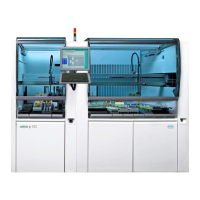Part F - Appendix cobas p 512
6-18 Operator's Manual – Version 1.6 - 10/2015
Definition of the parameters to be delivered on starting a certain
program.
Classification of different programs by types.
Lockable doors on the barcode printing module and the sorting area.
They protect the operator from injury.
Flap at the rear side of the system.
A list of programs or groups of programs, which may be executed at a
time that can be rolled up.
Cylinder which presses the tubes into the secondary tube transport.
Type of carrier to accommodate a certain number of sample and
reagent vessels on the aliquoter system.
Conveyor on which racks are transported over the various system
processes.
Carrier that accepts 20 or 30 Hitachi 5pos racks.
Different rack geometries are defined via the rack type.
Allergy test application.
Sensor which counts the motor steps of an axis. Information then sent
to controller in order to recognize motor step errors.
Determines accurate processing of sample tubes.
Sample material taken from patient and contained in sample tubes.
Taking up the fluid, e.g. sample material.
Position where the bar-coded tubes are read.
Values cannot be entered in any place of the screen but only via
marked input fields and within a defined range.
A special empty unlabeled tube which receives pipetted sample
material (material from the primary sample).
Computer system which administers the patient data and results from
connected analysis systems.
Secondary vessels within a rack are approached in single steps.
Pushes the individual tubes onto the print transport.
Changes in configuration setting, which causes the program to carry
out a certain function or action.
The total area where the tubes are sorted. The area where the racks
and rack trays are positioned.
Three-axis system of the sorter module.
Files which are created during the sorting process. They contain the
sorting data (barcodes, test, and sorting targets).

